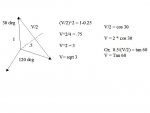After reading the entire original thread I did not see the answer so here's my input. I've been doing industrial electrical and instrumentation work for 38 years, starting out as an apprentice electrician and working up through the ranks to superintendent. I now work in the corporate office as a Senior Lead estimating and providing project support. There are many times I have to use formulas to calculate things like cable size, ckt ampacity, and transformer/generator sizing to name a few. These are the formulas I use on a regular basis (3 phase only).
Amps when Voltage and HP are known:
(Horsepower * 746) / (Volts * Efficiency (.85) * Power Factor (.80) * 1.73)
If Efficiency and/or Power Factor are not known I use .85 and .80 which are typical values.
Amps when Voltage and Kilowatts are known:
(Kilowatts * 1000) / (Volts * Power Factor (PF) * 1.73)
Kilowatts when Voltage and Amps are known:
(Volts * Amps * PF * 1.73) / 1000
Kilovolt-Amperes (KVA) when Voltage and Amps are known:
(Volts * Amps * 1.73) / 1000
Horsepower when Voltage and Amps are known:
(Volts * Amps * Efficiency % * PF * 1.73) / 746
(It takes a horse one hour to lift 746 pounds)
The phase voltage multiplied by 1.73 gives us the line voltage: 277V (As measured from phase to neutral or gnd) * 1.73 = 479.21 (or 480V nominal) which is the most common 3 phase circuit in industrial applications. 480V 3ph is used to power motors and tank heaters while the 277V single phase of the 3 phase system is commonly used for lighting.
I hope this helps to answer the original question. I'd greatly appreciate it if somebody can answer my original question which came up when I was updating my spreadsheet with these formulas and wondered... Why is it the square root of three (1.732)???
I'm sure I learned this back in college but can't remember, not that I'm getting old or have killed too many brain cells...



